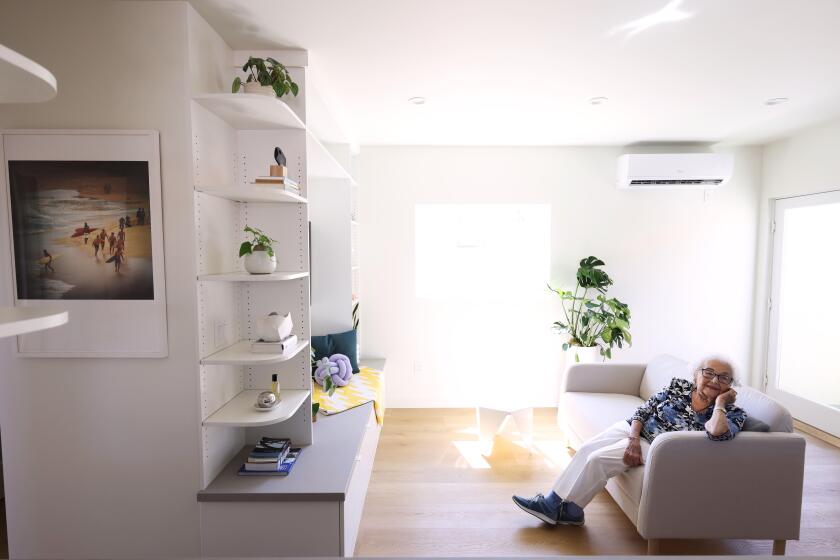Remaking it Wright
In 1940, when Life magazine ran a feature story about a Brentwood home designed by Frank Lloyd Wright Jr., the spotlight fell on the actress who lived there and not on the architecture. A big star, Jean Arthur had just appeared in the much-lauded film “Mr. Smith Goes to Washington,” and the details of her life, down to the canopied bed she slept in, were given plenty of ink. But the work of the eldest son of America’s greatest 20th century architect received just passing notice. Although Lloyd Wright, as he is known, never achieved the stature of his dad, he was a popular architect in Hollywood in the middle of the last century. And now, as the taste for early Modernism has grown in recent years, Wright’s work is being noticed again.
Wright’s eclectic career included many projects with his father, as well as a stint under the great early Modernist architect Irving Gill and work as a production designer at Paramount Studios. He also designed two successive shells for the Hollywood Bowl stage that established the model for its form today. When Wright died in 1978, he left a legion of upscale houses in varying styles, many of them in and around Los Angeles.
Some of his home designs appear greatly influenced by his father; others are far less idiosyncratic, distinctive not so much for extravagant auteurship as for simple Modernist geometry and accommodation to the Southern California landscape. Such is the case of the house Arthur once filled with her knickknacks, a home designed in 1934 and completed in 1937 for a previous owner. Taking advantage of spectacular views to the west of a then-undeveloped Mandeville Canyon, the house is set far back on a large lot, giving it an unusually wide sweep of front lawn that serves as both a grand entrance and an inviting landscape for entertaining. Built into a steep hillside with a pool area behind it, the house follows a simple L-shaped plan and stands three stories high at its axis, with the master suite at the top and guest rooms on the lower level. The public rooms, including the grand living and dining rooms, are long and somewhat narrow, emphasizing the views and providing a blank slate to showcase the contemporary tastes of the current owners.
To update the house, the homeowners hired the Los Angeles-based firm Rios Clementi Hale Studios, which expanded slightly on the original footprint and framework of Wright’s design with a new exercise room, enlarged garage and two small outdoor courtyards. Lloyd Wright’s work often is not as respected as his father’s, and much of it has been radically altered over the years, says Dana Hutt, an architectural historian and co-author of a monograph on the younger architect. In this case, however, the basic beauty of Lloyd Wright’s design was seen as a core value, and all additions and changes were intended to amplify his essential forms.
Lead architect Mark Rios’ major achievement was in “cleaning up” both the exterior and interior and emphasizing the inherent geometry with new, more modern details. The clients, a bicoastal couple who fell in love with the house after renting it for several years, are art collectors, and the demure spaces, along with the interior designs by Waldo Fernandez, now highlight the couple’s brightly colored holdings.
Sensitive to Wright’s plan, the architects stripped the interior of the false ceilings and decorative moldings that had been added to accommodate the previous owners’ tastes, upgraded all surfaces, opened up the living room, which had been divided into two spaces, and expanded some windows to enhance views.
“We purified the interior volumes by making forms crisper,” Rios says. “We’re very conscious in our work of trying to intensify the spirit of the original architect’s idea.” He calls Wright’s design “revolutionary for its placement on the lot and the geometric resolution of the house.” Rios’ additions emphasized the house’s planar simplicity by replacing awnings with trellises and the tile roof with metal facing.
The architects also reworked the landscaping, creating a geometric design that matches the house. Where the substantial front lawn once was open to the street, a new wall has created an entry garden and turned the grassy expanse into a private area for entertaining. A shallow pool and quiet fountain parallel the bluestone walkway that leads to the front entrance. At the rear, an infinity pool appears to flow into a wall of bamboo. “We wanted to make it all very simple and modern,” Rios says. “We wanted it formal, axial and edited.”
Inside, white walls contrast with rich walnut floors. A rebuilt mahogany staircase retains the form of the original. Small surprises abound, such as the breathtaking view of the hills from the breakfast room, or the streamlined kitchen whose stainless-steel Bulthaup cabinets fit so elegantly and efficiently into the space that, as Fernandez points out, “they feel like they could be on a first-class train.” The exercise room and an office face a meditative interior garden, a respite from both the physical and intellectual.
Fernandez, best known for his work for Elizabeth Taylor, did not skimp on color or elegant finishes, such as 16 coats of lacquer on large sliding doors that divide spaces. A purple living room set stands out, which Fernandez says was the owner’s choice. “I use a lot of colors, but never purple except for Elizabeth Taylor, who is a purple person. It turns out this owner was a purple person as well.” He also designed playful lamps, and he raised the bar for grandeur with a dining table topped with white-gold leaf under clear glass that makes the room shine. Sparkling from every surface, the house looks as if it were finished just yesterday, a combination of historical and contemporary refinements that are surprisingly harmonious.
*
Resource Guide
Rios Clementi Hale Studios, Los Angeles, (323) 634-9220. Waldo Fernandez, Waldo’s Designs, Los Angeles, (310) 278-1803.






